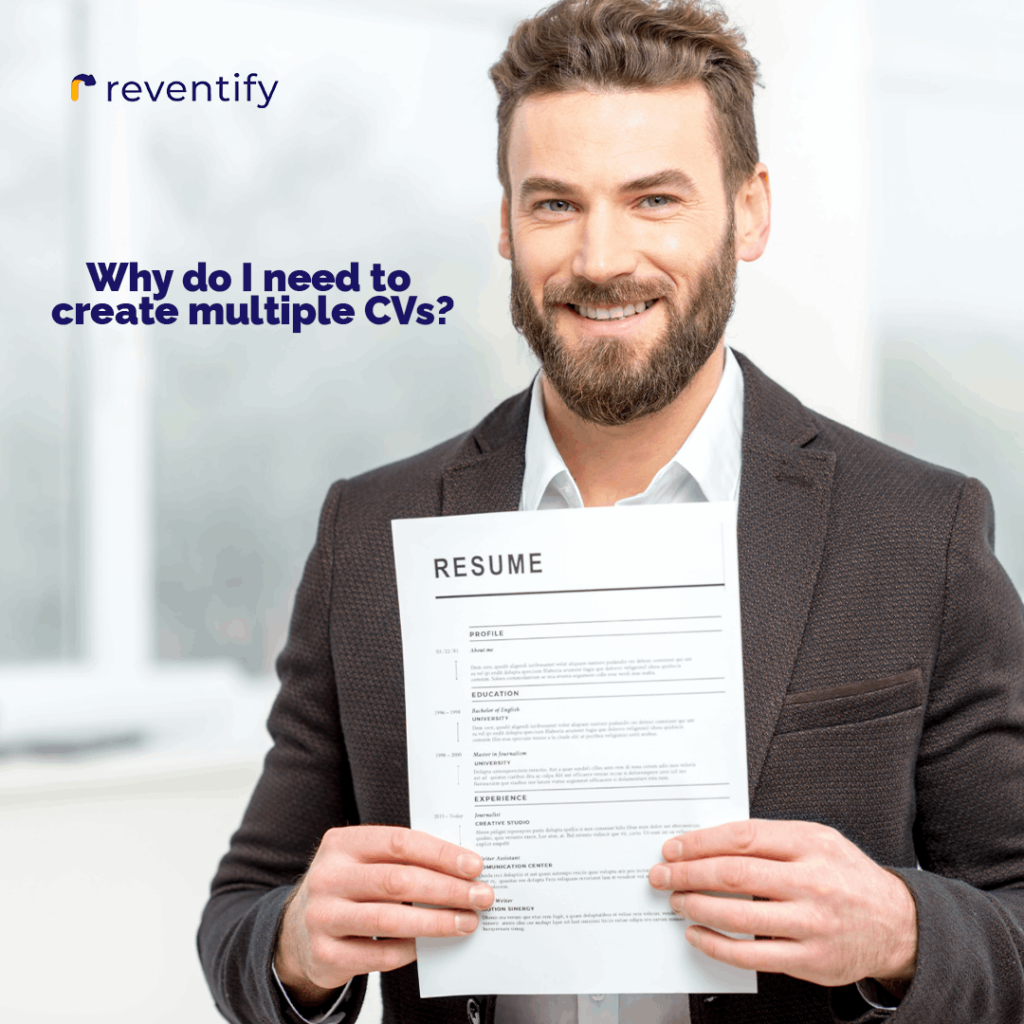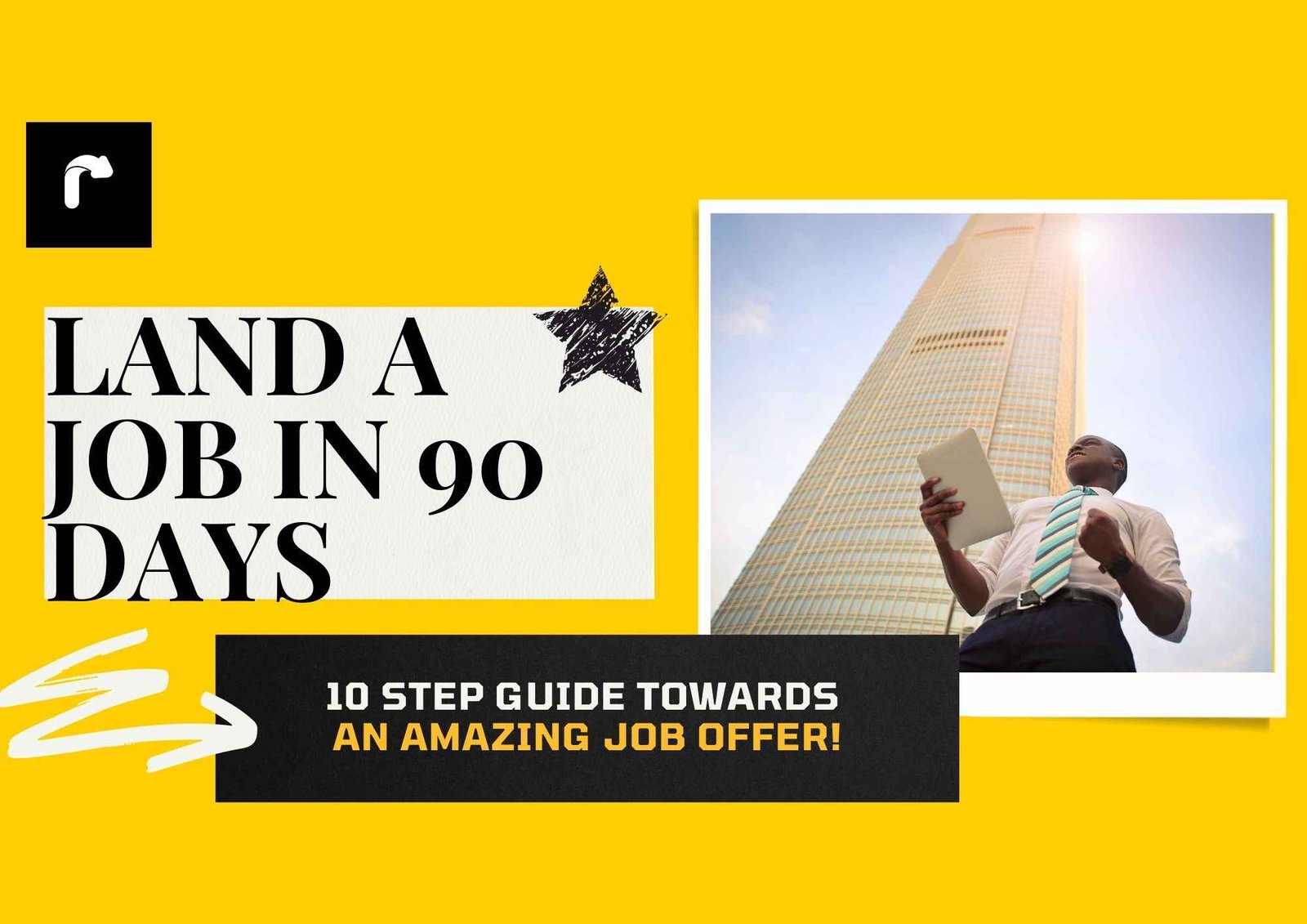Are you familiar with the common job search horror story? You know the one. The person is qualified on paper to land a wide variety of jobs. Yet still, for some reason, they struggle for months, sometimes a year, to land a suitable job.
You know the worst part? That situation could have been avoided if they knew the right way to approach job hunting. Luckily, you’re not going to make that same mistake. Because in this article we’re going to share our approach to finding a job in 90 days!
Now, that might sound too good to be true. But once we start going through our 10 step process, we’re sure you’ll see why we know our method is much more effective than the typical way of applying to jobs.
Here’s a quick preview:
- Develop a career plan
- Create a Master CV
- Build your professional network
- Conduct informational interviews
- Use multiple resources to look for jobs
- Tailor your CV to each job application
- Apply for multiple jobs
- Optimize your LinkedIn profile
- Ask for referrals and references
- Communicate with hiring managers throughout the hiring process
But before we dive in, we need to answer the question that we know is anxiously running through your mind right now…
Is 3 Months Enough Time to Find a Job?
Yes, 3 months (90 days) is enough time to find a job — even during a global pandemic. According to the National Bureau of Statistics, Nigeria has an unemployment rate of 33%, therefore 1 out of 3 people in the country don’t have jobs. For those that have a job, the average time taken to land a job offer exceeds 9 months.
The Nigerian job market, similar to that of many developing countries across Africa is highly competitive and therefore, if you’re one of the people reading this article without a job or unsatisfied with your current role, we are going to show you exactly what you need to do over the next 90 days to get at least one job offer.
What you need to promise us is that you’re going to follow these exact steps without fail!
So, let’s begin!
10 Steps to Find a Job in 90 Days
If you’re used to creating one CV and then sending it out to any job that seems vaguely interesting, then it’s time for a change. That method rarely works — as you probably know far too well.
For a better way, follow these 10 steps closely. And by the end of 90 days, you’ll either have a job offer, interviews, or (at least) a solid and effective plan of landing a decent job soon!
Step 1: Develop a Career Plan
Before you even begin to look for jobs, you need to know what you’re looking for. Because you’re not just looking for any job. You’re looking for a job you’ll enjoy — a job that won’t leave you searching for the next one just weeks after starting.
And the best way to find that type of job is to begin your job search with a solid career plan. How do you develop one of those? Self-evaluation.
What are your top hard and soft skills? What job title do you hope to have in 5 years? What about your ideal salary? And if you’re currently employed, what do you like about your current job? What do you dislike? Is it important that you get to continue developing certain skills in your next job?
Once you’ve answered those types of questions, create a plan that includes your goals for the next 90 days. Then, write out actionable steps you’ll take to achieve those goals.
Step 2: Create a Master CV
You’ll need to tailor your CV. Most companies don’t care to see every single work experience you’ve ever had. They only want the information most pertinent to the job at hand.
BUT you should have a record of every career experience that you might include on your CV. This is called a Master CV and it serves two purposes:
- It ensures you don’t forget any of your relevant experiences when you’re creating your tailored CVs
- It makes it easy to quickly put together those tailored CVs because you can just literally copy and paste without needing to rewrite, reformat, or revise the wording every time
What should go on your Master CV? Good question! Your Master CV should include all of your:
- Work and internship experience with bullet points detailing measurable accomplishments (e.g. helped raise revenue by 21%) and core responsibilities
- Volunteer and extracurricular experience with bullet points detailing accomplishments and core responsibilities
- A list of both your hard and soft skills with examples of how you’ve used them in a work setting
- Higher education degrees, career-specific certifications, workshops, and trainings
- Honors, awards, grade point averages, and special achievements like presentations or publications
- Information about any memberships in career-related groups
- Contact information for people you might list as references
This might seem like a lot of effort at first. But you’ll thank yourself for creating a Master CV when you reach step 6!
Step 3: Build Your Professional Network
If you already have a robust network, begin reaching out to people within the industry or companies you hope to work with. Let them know you’re in the process of finding a job. Don’t be afraid to ask if they know of any job openings or if they can connect you with someone who might.
Even if you’re new to networking, there’s a lot of ways you can quickly build the professional network you need to find a job quickly. For example, you can:
- Reach out to old classmates and colleagues
- Join and contact members of your university’s alumni club
- Attend professional meetups, conferences, and workshops online and in-person
- Connect with professionals with similar career paths on LinkedIn
- Cold email people you admire in your field/dream companies and ask them if they’re available for an informational interview
Step 4: Conduct Informational Interviews
Even if you already have a robust professional network, you should conduct informational interviews. Not sure what that is? No problem.
An informational meeting is a meeting to learn about the experience of someone working in a field, role, or company that interests you. Because informational interviews are 1-on-1, they’re one of the best ways to build meaningful professional connections.
They’re also your opportunity to ask questions about their career trajectory, receive insights about their company’s hiring process, and get advice on how to advance your career. How do you get this information? You ask questions like:
- How did you get into your current role?
- What do you like most about your job/company?
- Where do you see this industry/company headed in the next 5 years?
- What was the hiring process like?
- What type of person succeeds at your company?
- If you were in my position, what would you do to get to where you are in your career now?
If you’ve never conducted an informational interview before, check out the Harvard Business Review’s article on How to Get the Most Out of an Informational Interview.
Step 5: Look for Jobs Using Multiple Resources
Don’t limit your job search to one or two online job boards. Use multiple. But also take your job search efforts offline. According to some estimates, up to 70% of open jobs aren’t listed online.
So, if you’re determined to find a job in 3 months, you’ll need to look in more places than one and use multiple resources. How do you do that? In addition to online job boards, you should also:
- Ask your professional network, friends, and family
- Look at company career pages and social media pages
- Go to career fairs
- Contact recruiting agencies
Step 6: Tailor Your CV to Each Job Application

You created a Master CV in step 2. But remember that one is just for your reference. For every job you apply for, you should create a new CV that is tailored specifically to the job and company.
Why do this? Because hiring managers are scanning your resume looking specifically for keywords and phrases that signal you have the right skills and experience for the role. So, you want to make sure you’re only showing them the information they need for that evaluation.
Hiring managers are also usually put off by generic CVs because it shows a lack of effort. According to one study, 54% of recruiters report rejecting resumes or CVs that aren’t tailored to the job. You don’t want that!
So, here’s how to tailor your CV to a job:
- In your resume summary or resume objective, mention the company by name and use the same job title in the job ad to talk about your experience
- Scan the job description using a tool like this one to find the keywords and skills you need to include in your CV
- Use those exact skills and keywords in your work experience bullet points, skills section, etc. (This is extremely important since many companies now use ATS software to scan CVs to first decide if they’re worth a human looking at them)
- Put your most relevant work experience at the top of your resume
- Research the company to make sure you’re aligning your personal brand with the company’s brand
Step 7: Apply for Jobs You’re Qualified For
Tailoring your application and CV to each specific job takes time and effort. And you may be tempted to start throwing your CV at every available job opening in order to increase your chances. Please don’t do this! It never works. Getting a job is not a game of chances, it requires strategic effort on your part.
Yes, you need to apply for multiple jobs but you also need to be selective. Why? According to Glassdoor, the average corporate job receives 250 applications and only 4-6 candidates get called in for interviews. I can assure you that they don’t select applicants based on luck or by random. The hiring manager goes through a pre-defined process that only the top 5% of candidates would get through.
How many jobs should you apply for? There’s no exact number that guarantees success. But, generally, you should be aiming to apply for 4-5 jobs per week.
Yes, that means submitting a job application every working day, which is a substantial amount of work. But, with time, you’ll get faster at putting together the applications. And all that hard work will feel worth it when you start getting interviews and (hopefully) have multiple job offers to consider.
Step 8: Optimize Your LinkedIn Profile
Don’t undervalue the importance of your LinkedIn profile. It’s not just a digital copy of your resume. It’s a reflection of your personal brand. And hiring managers, recruiters, and potential connections will look at it to evaluate your fit for work opportunities.
To optimize your LinkedIn profile, start by making sure each section is filled out. Make sure it’s clear what your skills and areas of expertise are. And don’t stop there. With a complete profile, you now have a draft to refine and improve further.
Your next steps include things like:
- Making sure you’re using the right keywords for your desired role in your LinkedIn headline, work experience, and summary section
- Uploading a high-quality profile and cover photo
- Listing and getting endorsements for the most desired skills for someone in your field
- Reaching out to your contacts for recommendations
Those are just a few examples. For more tips, take a look at this LinkedIn profile guide full of even more tips and examples.
Step 9: Ask for Referrals and References
If you can get a referral from someone working at the company, you can give yourself a huge advantage. Why do we say that? Because companies favor candidates who their trusted employees already see as a good fit for the role and company.
According to a Jobvite study, 40% of hires come from referrals. Research also shows that referred applicants become better employees in the long run.
But how do you get a referral if you don’t know someone working at one or more of your dream companies? Networking!
For example, you might be able to get a referral from someone in your existing network or by continuing to build a professional relationship with someone you conducted an informational interview.
Step 10: Communicate with Hiring Managers Throughout the Hiring Process
You never want the hiring manager to doubt your interest in the job. And to do that you need to stay at the top of their mind throughout the hiring process.
That means you’re sending regular follow-up emails, updating them on any new achievements or experiences that make you qualified for the job. You can also be proactive by demonstrating how you might approach some of the core responsibilities of the job if hired.
Final Thoughts
You’re not alone if you think finding a new job is hard and takes a lot of time. It definitely can be. But you can give yourself a good shot of landing a job in as soon as 90 days by following the 10 steps we’ve shared in this article.
And if you want even more advice on how to land your dream job, consider signing up to our HR Connect platform, where our network of hiring managers at the companies you dream of working, can walk you through everything from preparing your career plan to developing the profile required for you to get great job offers!




